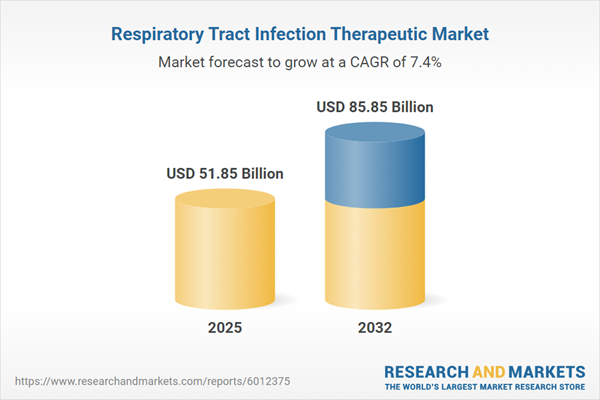Speak directly to the analyst to clarify any post sales queries you may have.
The respiratory tract infection therapeutic market is evolving, driven by innovative treatments, advanced diagnostics, and greater emphasis on tailored patient care. Industry leaders seek reliable insights to position themselves competitively as the landscape shifts with technological progress and new regulatory models.
Market Snapshot: Growth and Strategic Momentum in the Respiratory Tract Infection Therapeutic Market
The respiratory tract infection therapeutic market grew from USD 48.43 billion in 2024 to USD 51.85 billion in 2025. It is expected to continue growing at a CAGR of 7.41%, reaching USD 85.85 billion by 2032. This upward trend highlights expanding demand across acute and chronic infection management as demographic shifts and antimicrobial resistance drive the need for advanced therapies worldwide. Senior decision-makers are evaluating solutions that align with emerging patient needs and strengthen patient care infrastructure.
Scope & Segmentation: In-Depth Coverage of the Respiratory Tract Infection Therapeutic Market
- Therapeutic Type: Antibiotics (Fluoroquinolones, Macrolides, Penicillins, Tetracyclines), Antivirals, Cough Suppressants, Nasal Decongestants, Non-Steroidal Anti-Inflammatory Drugs.
- Infection Type: Lower Respiratory Tract Infection, Upper Respiratory Tract Infection.
- Patient Type: Adults, Geriatrics, Pediatrics.
- Route of Administration: Inhalation (Metered Dose Inhalers, Nebulizers), Oral (Liquid Suspensions, Tablets), Parenteral.
- Geography: Americas (North America, Latin America), Europe, Middle East & Africa (Europe, Middle East, Africa), Asia-Pacific (China, India, Japan, Australia, South Korea, more).
- Company Coverage: Abbott Laboratories, Alkem Laboratories Limited, AstraZeneca PLC, Boehringer Ingelheim GmbH, Cadila Healthcare Limited, Cipla Limited, F. Hoffmann-La Roche AG, GlaxoSmithKline plc, Glenmark Pharmaceuticals Limited, Hikma Pharmaceuticals PLC, Intas Pharmaceuticals Limited, Lupin Limited, Merck & Co., Inc., Mylan Inc. by Viatris Inc., Novartis International AG, Pfizer Inc., Sanofi S.A., Steris Healthcare Pvt. Ltd., Teva Pharmaceutical Industries Ltd.
Segmentation insights reflect varied development priorities: antibiotics address molecular innovation and resistance management, while antivirals and supporting therapies diversify strategies for symptom control. Distinctive delivery mechanisms and patient segmentation guide tailored formulation and dosage design.
Key Takeaways: Strategic Insights for Decision-Makers in Respiratory Tract Infection Therapeutics
- Technology is redefining the sector, with advances in high-throughput diagnostics and novel delivery systems supporting rapid, precise interventions.
- Precision medicine, including metered dose inhalers and digital health tools, enhances patient monitoring, adherence, and personalized care delivery.
- Regulatory shifts facilitate faster market access for promising therapies, while collaborative public-private partnerships accelerate clinical development and real-world adoption.
- Segmented approaches targeting adults, geriatric, and pediatric patients optimize outcomes and capture previously underserved market segments.
- Integration of antimicrobial stewardship influences both research prioritization and post-market surveillance, improving sustainability of therapeutic efficacy.
Tariff Impact: United States Policy Effects on Supply Chains and Market Access
Recent United States tariff policy updates have increased input costs on raw materials and active ingredients. This has prompted manufacturers to adopt near-shoring, pursue supplier diversification, and strengthen regional partnerships to stabilize procurement. Adjustments in research collaborations and manufacturing timelines reflect the industry's agile response to evolving policy and regulatory scrutiny, ensuring continued therapeutic pipeline resilience and access.
Methodology & Data Sources: Comprehensive and Validated Intelligence
The research integrates secondary analysis of peer-reviewed literature, regulatory filings, and trial registries along with direct interviews of clinical leaders and industry executives. Quantitative and qualitative findings are cross-referenced and refined through stakeholder workshops to ensure accuracy, reliability, and actionable insight into the therapeutic landscape and segment performance.
Why This Report Matters: Actionable Guidance for B2B Leaders
- Harness robust segmentation and regional insights to inform strategic planning and resource allocation in a dynamic, competitive market.
- Identify supply chain risks and opportunities, particularly in light of policy changes affecting global and domestic manufacturing.
- Evaluate technology adoption, regulatory trends, and emerging partnership models to prioritize high-impact investments and collaboration opportunities.
Conclusion
This report enables industry leaders to recognize transformative shifts and respond confidently to clinical, market, and policy-driven challenges. Strategic adoption of innovation, collaborative alignment, and patient-focused portfolio development will sustain long-term advantage in respiratory tract infection therapeutics.
Additional Product Information:
- Purchase of this report includes 1 year online access with quarterly updates.
- This report can be updated on request. Please contact our Customer Experience team using the Ask a Question widget on our website.
Table of Contents
3. Executive Summary
4. Market Overview
7. Cumulative Impact of Artificial Intelligence 2025
Companies Mentioned
The companies profiled in this Respiratory Tract Infection Therapeutic market report include:- Abbott Laboratories
- Alkem Laboratories Limited
- AstraZeneca PLC
- Boehringer Ingelheim GmbH
- Cadila Healthcare Limited
- Cipla Limited
- F. Hoffmann-La Roche AG
- GlaxoSmithKline plc
- Glenmark Pharmaceuticals Limited
- Hikma Pharmaceuticals PLC
- Intas Pharmaceuticals Limited
- Lupin Limited
- Merck & Co., Inc.
- Mylan Inc. by Viatris Inc.
- Novartis International AG
- Pfizer Inc.
- Sanofi S.A.
- Steris Healthcare Pvt. Ltd.
- Teva Pharmaceutical Industries Ltd
Table Information
| Report Attribute | Details |
|---|---|
| No. of Pages | 199 |
| Published | November 2025 |
| Forecast Period | 2025 - 2032 |
| Estimated Market Value ( USD | $ 51.85 Billion |
| Forecasted Market Value ( USD | $ 85.85 Billion |
| Compound Annual Growth Rate | 7.4% |
| Regions Covered | Global |
| No. of Companies Mentioned | 20 |









